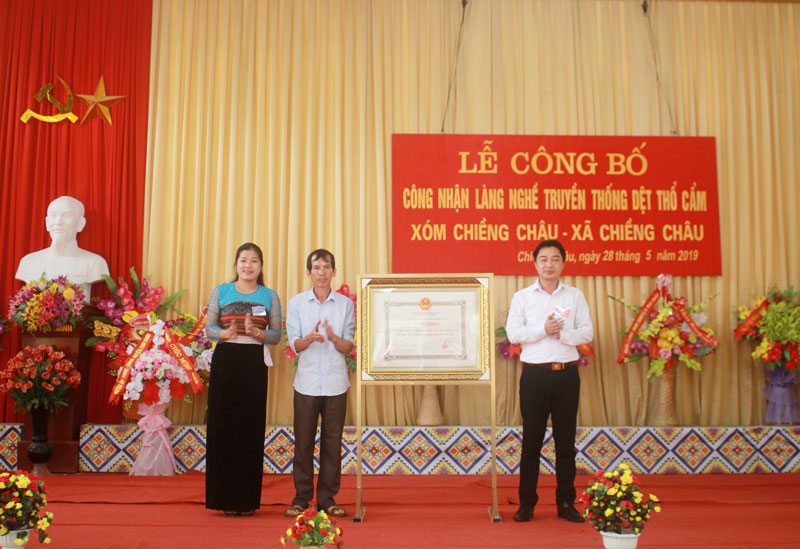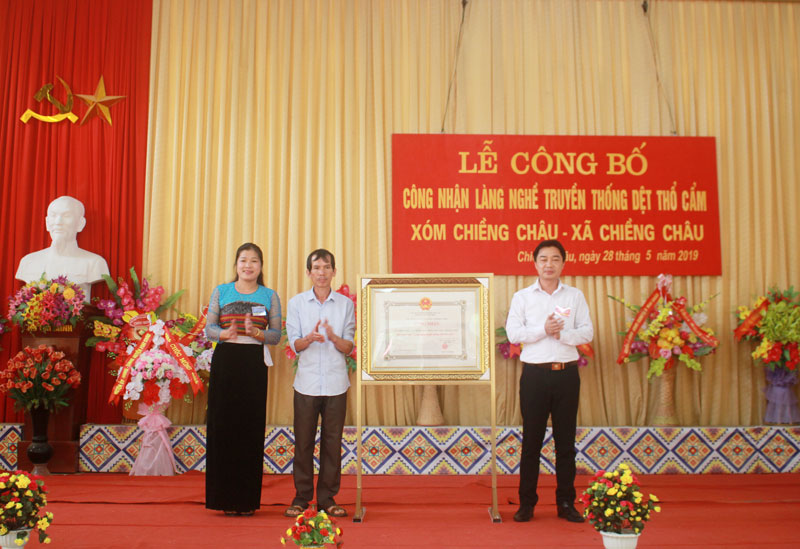
(HBO) - Chieng Chau was recognised as a traditional craft village at a ceremony held in Chieng Chau commune by the communal People’s Committee on May 28.
 Representatives from Mai Chau
district present a decision to Chieng Chau hamlet, Chieng Chau commune, to
recognize the locality as a traditional craft village of brocade weaving.
Representatives from Mai Chau
district present a decision to Chieng Chau hamlet, Chieng Chau commune, to
recognize the locality as a traditional craft village of brocade weaving.
Chieng Chau brocade weaving has
been existing for a long time. In 1955, many handicraft artisans were known. Brocade
weaving in Chieng Chau hamlet recorded the strongest development from
1990-2000.
Most of the households in the
village have 1-2 looms, meeting the shopping need of domestic and foreign
tourists. Brocade values have been improved, contributing to increasing income
for locals.
At present, Chieng Chau brocade weaving is always maintained and developed in the
form of the combination of modernity and traditionality, contributing to the
generation of jobs and income for women, and promoting trade craft tourism potential
to customers inside and outside the locality, thus improving living standards
for locals.
On the occasion, representatives
from Mai Chau district handed over the decision of recognizing Chieng Chau as a
brocade weaving craft village, and presented certificates of merits to 18
outstanding individuals for their contributions to the development of brocade
weaving in the locality./.
With an increasingly vibrant and widespread emulation movement aimed at building cultured residential areas and cultured families, Yen Thuy District has been making steady progress toward improving both the material and spiritual well-being of its people, while fostering a civilized, prosperous, beautiful, and progressive community.
Once lacking recreational spaces and community facilities, Residential Group 2 in Quynh Lam Ward (Hoa Binh City) has recently received attention for the construction of a new, spacious, and fully equipped cultural house. The project followed the model of state support combined with public contributions in both labor and funding.
The "All people unite to build cultural life" movement, which has been effectively integrated with Kim Boi district’s socio-economic development goals, is fostering a lively spirit of emulation across local residential areas, hamlets, villages, public agencies, and enterprises. In addition, through the initiative, traditional cultural values are being preserved and promoted, while community solidarity and mutual support in poverty reduction and economic development are being strengthened.
A working delegation of the Hoa Binh provincial People’s Committee led by its Permanent Vice Chairman Nguyen Van Toan on June 11 inspected the progress of a project to build the Mo Muong Cultural Heritage Conservation Space linked to tourism services in Hop Phong commune, Cao Phong district.
Born and growing in the heroic land of Muong Dong, Dinh Thi Kieu Dung, a resident in Bo town of Kim Boi district, in her childhood was nurtured by the sweet lullabies of her grandmother and mother. These melodies deeply imprinted on her soul, becoming an inseparable part of her love for her ethnic group's culture. For over 20 years, this love for her hometown has driven Dung to research, collect, and pass down the cultural values of the Muong people to future generations.
In the final days of May, the Ethnic Art Troupe of Hoa Binh Province organized performances to serve the people in remote, mountainous, and particularly disadvantaged areas within the province. These were not just ordinary artistic shows, but they were the meaningful journeys aimed at spreading cultural values, enhancing the spiritual life of the people and contributing to the preservation of ethnic minority cultural identities.



 Representatives from Mai Chau
district present a decision to Chieng Chau hamlet, Chieng Chau commune, to
recognize the locality as a traditional craft village of brocade weaving.
Representatives from Mai Chau
district present a decision to Chieng Chau hamlet, Chieng Chau commune, to
recognize the locality as a traditional craft village of brocade weaving.